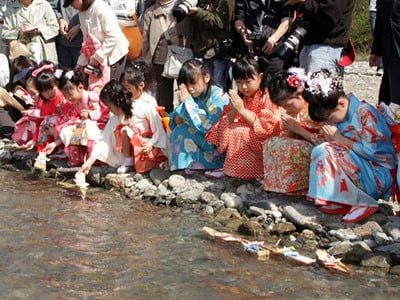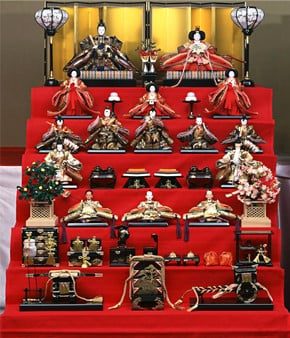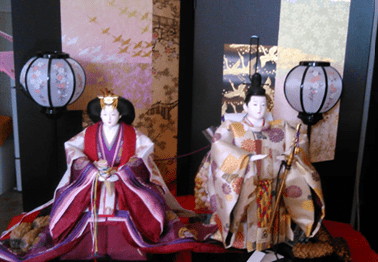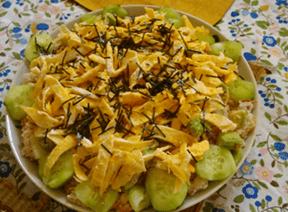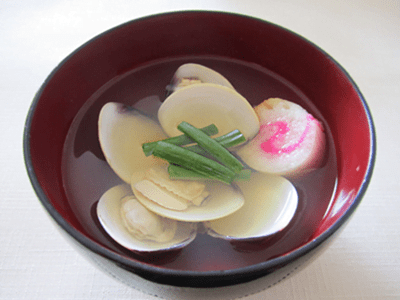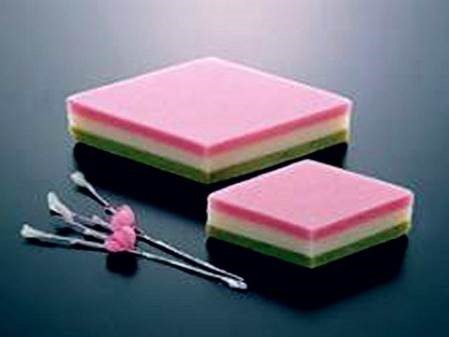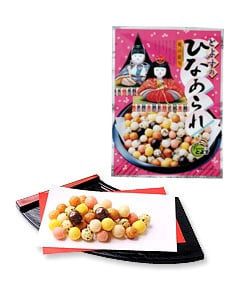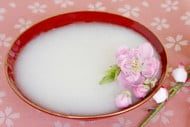あかりをつけましょ ぼんぼりに
おはなをあげましょ もものはな
5にんばやしの ふえだいこ
きょうは たのしいひなまつり
Let’s light the oil lamps
Let’s add the flowers, the peach blossoms
Five court musicians, with drums and flutes
Today is joyful Hinamatsuri!
This song is heard everywhere on March 3, the Day of Girls and Dolls, called Hinamatsuri (ひなまつり) in Japanese. The festival is similar to Tanabata, celebrated on July 7, in that it was borrowed from China. By today it has become a part of Japanese tradition and is deeply imbedded in Japanese culture.
Essentially, Girl’s Day is an invocation for “the happiness of little girls.” A mission from China very long ago brought the holiday to Japan as a cultural phenomenon. The imperial court disseminated the holiday during the Heian Period (794 to 1185).
Back at the start instead of having dolls, people folded paper into two-dimensional figures. They then touched other people with the figurines to extract the evil lurking within them. The evil thus collected was allowed to float away in the river and thus the people became cleansed. The figuring-floating ceremony is called Nagashi-bina and it continues to be a part of today’s ceremony.
How do we, Japanese, generally mark this day? We take out the Hinamatsuri dolls and set them up in the house. When I was little, my parents would set up the Hinamatsuri dolls on a step-like platform:
The emperor and empress are in the top row. Below them are the empress’s three ladies-in-waiting (三人官女). Under them are the five imperial musicians(五人囃子). Under the musicians are two ministers(随身). The lowest level is for the servants(衛士), the emotional drunkard, the joyful drunkard, and the angry drunkard. The empress’s doll portrays her at the age of 18.
The steps on which the Hinamatsuri dolls sit are covered by a crimson fabric. The color is important. The gates to Shinto temples are the same shade of red. In this case the red is a good-luck sign, a sort of amulet or talisman. There is also a peach tree on the steps, to keep evil spirits away. In the center is a wooden mochi (a wooden copy of a Japanese sweet) which symbolizes the human heart.
Sadly, we live in a rather small cottage so all we could put out for my daughter was what appears on the photo (only the emperor and empress).
This year, given my low energy level and a lack of materials, we celebrated Hinamatsuri at home with the following menu.
Chirashi Zushi (with avocado and salmon), tofu and wakame miso soup (not customary for Hinamatsuri), seaweed, mango leaves and white wine from Hungarian Irsai Olivér grapes.
Customary Hinamatsuri menus follow
Dishes for Hinamatsuri
Clam soup
It is supposed to promote a lifelong spousal relationship, a good marriage.
Rhombus-shaped mochi (rice cake dessert)(ひしもち)
Legend has it that each of the three colors has its own meaning. The green symbolizes health and long life. The white is for purity, innocence, and the pink protects from evil spirits. In the picture below we can see all three colors together. Here the green is the soil, the white is the snow, and the pink is the peach tree. Looking at it this way, the peach tree growing out of the snow truly symbolizes this dessert. The rhombus shape is a reference to the human heart. The parental message to their daughters is to offer their very best wishes.
River pebbles (Hinaarare ひなあられ)
These little balls are green, yellow, and white, and are, they say, a reference to the four seasons. The starch inside them is healthy and tastes good, too. The pebbles symbolize the wish for day-to-day happiness for our girls.
White sake (白酒)
Legend has it that once upon a time they drank sake adorned with petals of peach blossoms. The peaches chase away the evil spirits and improve stamina. Peaches comes from China and were originally brought into Japan for its medicinal properties.
Chirashi Sushi (ちらし寿司)
There is no set recipe for this sushi, and every family makes it differently. It generally includes shrimp, crab meat, lotus roots, seeds, and nori (a type of seaweed). Each of these foods offers good omens. Spring is greeted with leaves, roasted egg, carrots, and colorful foods. These are the ceremonious dishes served on this Day for Girls.
Legend has it that at the end of Girl’s Day the dolls must be packed away very quickly. If the dolls are left out for a long time it will take a long time for the little girl to found a marriage partner. (According to a 2013 survey 厚生労働省 the average age at which men marry is 30.9 years while for women it is 29.3 years.) Another approach says it is shameful if the housewife and mother is unable to get the dolls packed away before spring and good weather appear. We packed away the dolls on March 15th so I hope that won’t delay the wedding … because I have two dreams, to get to visit India and to be able to play with my grandchildren as soon as possible.
Some of the photos are my own (the text clarifies which they are), and the others come from the following sources, in order of appearance:
http://www3.pref.nara.jp; http://www.jikemachi.or.jp; http://www.metabo-help.com;
http://livedoor.blogimg.jp; http://www.toyosu.co.jp; http://yazuken.com; http://www3.mizkan.co.jp
